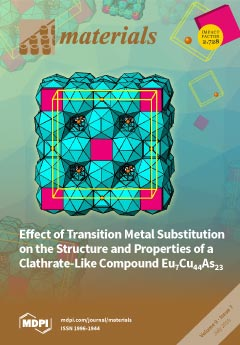Materials, Volume 9, Issue 7 (July 2016) – 111 articles
The transition metals Fe, Co, and Ni substitute Cu in a clathrate-like compound Eu7Cu44As23 to modify its magnetic properties while keeping its crystal symmetry intact. Unlike typical clathrates, Eu7Cu44As23 is an electronically imbalanced compound allowing a wide range of heterovalent substitutions. Spins of the Eu2+ (4f7) cations that reside in oversized cages of the framework tend to order ferromagnetically; however, Ni-substituted compound shows an increase in TC to 25 K, whereas substitution of Fe for Cu suppresses ordering. View the paper
- Issues are regarded as officially published after their release is announced to the table of contents alert mailing list.
- You may sign up for e-mail alerts to receive table of contents of newly released issues.
- PDF is the official format for papers published in both, html and pdf forms. To view the papers in pdf format, click on the "PDF Full-text" link, and use the free Adobe Reader to open them.






